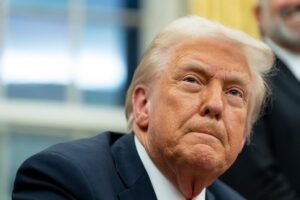Auto Industry Sees Silver Lining Amidst Trade Tensions
In an unexpected turn, auto stocks surged, primarily driven by Tesla (TSLA), as a temporary trade truce has emerged between the U.S. and China. While the auto sector itself remains excluded from this preliminary deal, optimism is palpable among investors.
Key Takeaways from U.S.-China Trade Talks
The recent 90-day pause on tariffs is a significant development that emerged from two days of intense negotiations. U.S. tariffs on Chinese goods have been adjusted, reducing from a staggering 145% to 30%, while China’s retaliatory duties have dropped from 125% to 10%. However, it’s crucial to note that sector-specific tariffs imposed prior to President Trump’s administration—specifically targeting "strategic sectors" like electric vehicles and steel—remain unchanged. Broader tariffs on auto imports and auto parts from China are still in effect.
While this pause is a breath of fresh air for many sectors, including the automotive industry, the long-term implications remain a topic of intense scrutiny.
Investor Sentiment Shifts
Despite the tariff exclusions for the auto sector, shares of major automakers like Tesla, GM (General Motors), Ford, and Stellantis are benefiting from investor optimism about potential forthcoming trade agreements. This speculation may help cushion the effects of Trump’s trade policies on corporate profitability and the broader economy.
Dan Ives, an analyst with Wedbush, emphasized this sentiment, stating, “We believe autos are next on the docket for the trade talks. This positive U.S.-China news could set the stage for future discussions focusing on the Big Three automakers and the U.S. auto industry.” This suggests that investors should keep a close watch for updates in the coming weeks, as developments could sway stock performance.
The Heavy Weight of Tariffs
Despite recent optimism, the reality is dire for automakers grappling with existing tariffs. GM anticipates that its full-year EBIT could be adversely affected by $4 billion to $5 billion, while Ford expects a $1.5 billion hit. Stellantis has even pulled its guidance altogether, signaling significant concern among major players.
Toyota (TM), perhaps feeling the most pressure, has estimated that tariffs will slice approximately $1.3 billion off its operating profits for just April and May of this year.
Both GM and Ford continue to import models like the Buick Envision and Lincoln Nautilus, respectively, from China. While these tariffs may have limited immediate impacts on those specific models, the broader 25% import tariffs on auto parts are more troubling and could significantly hamper production costs going forward.
A Call for Greater Certainty
Steve Patton, EY’s Americas automotive sector leader, remarked on the recent tariff adjustments: “This rollback is a welcome development that could alleviate immediate supply chain pressures. However, the industry requires greater certainty given the complexities of global supply chains.” This highlights a crucial point for automakers: while short-term relief is appreciated, long-term strategies must adapt to a landscape that is still riddled with uncertainty.
Conclusion
As the auto sector navigates through these trade waters, it’s clear that while temporary compromises offer hope, the ongoing tariff situation poses significant challenges. Investors and industry leaders alike must remain vigilant and proactive, anticipating changes that could reshape the automotive landscape. Keep an eye on how these developments unfold, as they will likely influence market dynamics moving forward.
The evolving relationship between the U.S. and China will continue to play a pivotal role in the fortunes of the automotive sector, and staying informed will be key for investors dedicated to maximizing their opportunities.

